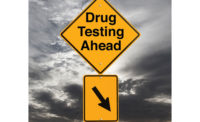Our society faces a widescale substance abuse issue. Data suggests the current drug overdose epidemic has accelerated significantly since the COVID-19 pandemic, and substance abuse issues are also spilling over into 75% of businesses today.
While substance abuse poses a significant risk to society at large, for businesses, it can have negative impacts on employees, managers, and even customers. In fact, among the 75% of businesses impacted, fewer than 17% feel prepared to handle them, proving that most businesses today lack the preventive and investigative resources needed to keep the entirety of their workforce safe. This rings exceptionally true in industries like construction, mining, transportation, and service occupations, which have some of the highest rates of substance abuse.
While it is a business’ legal responsibility to investigate reasonable suspicion of abuse, this can be a challenging and a somewhat taboo area to navigate. Furthermore, with so many businesses stating they’re unprepared for rising substance abuse issues, it’s evident that many organizations lack a formal policy as well as the resources to properly enforce it.
For employers looking to address these challenges, there are certain questions that need to be considered, such as:
- Is there a formal policy in place today that states how these issues should be investigated and resolved?
- Are employees educated and trained on that policy, as well as how to detect and then report substance abuse issues?
- Are there proper resources in place to help people that are found to be using abused substances at work?
If the answer is no to one or more of the above, it’s time to create – or revisit – how to thoroughly detect, investigate and prevent workplace substance abuse.
Formal policies to lead effective investigations
A formal policy and substance abuse program is typically the foundation to controlling substance abuse in the workplace. These policies not only streamline investigations and protect the company from litigation, but also set rules and expectations for safe workplaces.
A robust and effective policy takes many considerations into account, including:
- Understanding the laws and regulations, both at the state and federal level, that they must adhere to.
- Establishing policy objectives — for instance, reducing or eliminating drug-related workplace accidents, illnesses, and absenteeism.
- Establishing whether prevention and treatment of substance abuse will be integrated into broader business goals such as promoting employee health and safety.
A good policy also explicitly defines any nuances that could open doors for misinterpretation. For instance, which specific substances and behaviors are prohibited or when the policy is in effect (e.g., during work hours only or also outside of regular business hours). Without a clear understanding of how an organization defines substance abuse, it becomes more challenging to investigate, enforce and ultimately resolve.
Drug testing is also a critical component to building substance abuse policies and one of the best ways to confirm reasonable suspicion, or even to take preventive measures. The Occupational Safety and Health Administration (OSHA) states that most instances of workplace drug testing are permissible and can include testing under various organizational and regulatory circumstances including when it’s done:
- Randomly for preventive purposes.
- To evaluate the root cause of a workplace incident that harmed or could have harmed employees. If the employer chooses to use drug testing to investigate the incident, the employer should test all employees whose conduct could have contributed to the incident, not just employees who reported injuries.
- Under state or federal law such as a U.S. Department of Transportation rule.
If substance abuse violation is then confirmed following a drug test, leadership must then step in to enforce appropriate courses of action.
Training is essential to detecting signs of abuse
Training employees on the negative impacts of substance abuse is critical to maintaining workplace safety, but also ensures employees know what signs of substance abuse look like. This is a key step in creating the “speak up” culture needed to report suspicions.
There are many facets to a robust training program, but the most effectives strategies include:
Training employees and managers on what signs of abuse look like. Some of the more common signs include poor work performance, frequently calling out or arriving late, frequently changing workplaces, struggles with productivity, and theft.
Discussing the company’s substance abuse policy early and often. It should be introduced during orientation sessions for new employees, but also re-introduced to existing employees regularly through various means such as the employee handbook, posters in common areas at worksites, the organization's intranet, etc.
Ensuring reporting protocols are in place. If an employee or manager detects signs of abuse, it’s essential they feel safe to report, but also know how to report, what the next steps are, and what the expected outcome will be. Having these protocols in place fosters a speak up culture and maintains a safe workspace.
While there is no one-size-fits-all approach to training, the most important factor is to ensure there’s thorough communication about what the policy entails and that a “see something say something” culture exists.
Offering safety resources can save a life
Following an investigation where abuse is confirmed, the most important next step is offering safety resources for treatment. Oftentimes these resources can be available through a company’s Employee Assistance Programs (EAPs), which provide confidential counseling as well as support to employees dealing with personal issues, which includes substance abuse.
In addition to EAPs, there are other resources that can be beneficial to employees, including:
- Alternative pain management: Particularly in industries that are labor manual intensive, exploring non-opioid pain management options for employees with chronic pain issues can help reduce the risk of opioid dependence.
- Community Partnerships: Collaborating with local community organizations and treatment centers can offer resources and referrals for employees struggling.
- Employee assistance funds: Consider establishing an assistance fund to provide financial support to employees seeking treatment.
- Peer support programs: Implementing peer support programs where employees can connect with colleagues who have successfully overcome substance abuse issues, can provide inspiration and guidance to those in need.
There are also preventative options that can help reduce the risk of employees being tempted to abuse substances at work. For example, encouraging a healthy work-life balance to reduce stress and potential triggers for substance abuse, as well as fostering a culture of support and empathy where employees feel comfortable seeking help for their problems without fear of stigma or retaliation.
Substance abuse has long been a widescale societal issue, and businesses that are not prepared for its increasing impact will find it even more challenging to navigate. Substance abuse should no longer be considered taboo and will only continue to increase if businesses turn a blind eye. Having the proper strategies and resources in place to thoroughly investigate – and resolve – substance abuse issues is critical to protecting business operations, and more importantly, employees’ safety and wellbeing.



